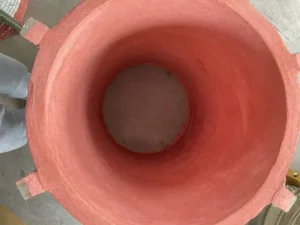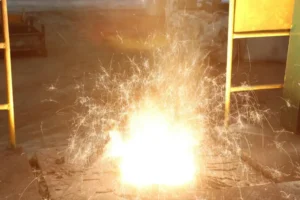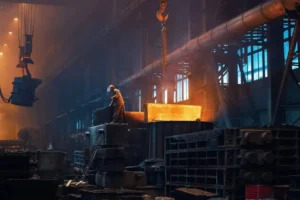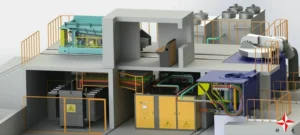Различные страны разработали уникальные характеристики и преимущества в технологии индукционной печи. Вот сравнение Германии, Соединенные Штаты, Япония, и Китай:
Характеристики и преимущества Германии
- Высокий Точность и стабильность: Немецкое промышленное производство известно своим тщательным мастерством и строгим контролем качества. В области индукционных печей, Немецкие компании сосредоточены на стабильности структуры тела печи, системы управления, и питания, обеспечение точного контроля и долгосрочной надежности процесса нагрева.
- Энергоэффективность и Относящийся к окружающей среде Защита: Германия является мировым лидером в области энергосбережения и защиты окружающей среды, и их продукты для индукционной печи отражают это. Они привержены повышению эффективности преобразования энергии, снижение энергопотребления, и разработка более экологически чистых материалов и процессов, например, Оптимизируя дизайн катушки и управление питанием для снижения потребления электроэнергии.
- Настройка и широкое приложение: Немецкие производители индукционной печи обычно предлагают высоко настраиваемые решения для удовлетворения конкретных потребностей различных отраслей промышленности (например, автомобильный, аэрокосмический, механическое производство). Их технология широко используется для гашения, пайка, Предварительное отопление, плавление, и другие поля.
- Технические стандарты и нормы: Германия играет важную роль в установлении промышленных стандартов и норм, который частично определил стандартизацию и высококачественную разработку своей технологии индукционной печи.
Характеристики и преимущества Соединенных Штатов
- Высокая мощность и большая Емкость: Соединенные Штаты имеют долгую историю в тяжелой промышленности, и его технология индукционной печи превосходит высокую мощность и большую мощность, Особенно в стальном и неплозном металлическом плавлении.
- Инновационные приложения и новые технологии: США. остается на переднем крае материальной науки и технологических инноваций. Они активно изучают применение индукционных печей в новых материалах, Специальные сплавы, и более продвинутые процессы (такие как таяние вакуумной индукции, направленное затвердевание). Например, в проектах с низким уровнем углерода, США. инвестировал в индукционные печи, чтобы заменить традиционные печи Cupola и электрические дуговые печи.
- Автоматизация и интеллект: НАС. Технология индукционной печи разработана в начале автоматизации и интеллекта, Интеграция расширенных систем управления, датчики, и анализ данных для достижения точного мониторинга и оптимизации производственных процессов, Повышение эффективности.
- Надежность и долговечность: НАС. Продукты для индукционной печи часто подчеркивают надежность и долговечность оборудования для удовлетворения требований долгосрочных, Высокоинтенсивное производство.
Характеристики и преимущества Японии
- Специализация в высокочастотном индукционном нагревании: Япония имеет значительное преимущество в высокочастотном индукционном нагревании, Особенно для упрочнения поверхности, термическая обработка, и пайка небольших заработков. Их технология обеспечивает краткосрочную работу, точное локальное нагревание с минимальной деформацией, и он легко интегрируется в автоматизированные системы.
- Энергетическая экономия и посвященное производству: Японское производство подчеркивает бережливое производство и энергоэффективность. Их технология индукционной печи имеет уникальные силы в энергетическом дизайне, уменьшение потери тепла, и повышение тепловой эффективности, который помогает снизить производственные затраты.
- Высокая надежность и работа: Продукты японской индукционной печи обычно имеют высокую надежность, низкие показатели отказов, и удобные для пользователя проекты для работы и технического обслуживания, Облегчение их использования и обслуживания операторов легко.
- Интеграция с материальной наукой: Япония может похвастаться сильными возможностями в исследованиях материальных наук, Объединение с технологией индукционного нагрева для разработки высокоэффективных индукционных решений для отопления для конкретных материалов.
Характеристики и преимущества Китая
- Масштабированное производство и Рыночный спрос: Китай является одной из крупнейших в мире странов для производства, с огромным рыночным спросом, который привел к быстрому разработке и крупномасштабному применению технологии индукционной печи. Китай имеет значительные производственные мощности и долю рынка в индукционных печи малых и средних мощных средств.
- Экономическая эффективность и Ценить за деньги: Китайская индукционная печь Продукты конкурентоспособны с точки зрения экономической эффективности и стоимости денег. По мере того, как внутренние технические уровни улучшаются, Многие китайские бренды подходят к международному продвинутому уровню в производительности, Но по более выгодной цене.
- Технологический прогресс и догоня: В последние годы, Китай добился значительного прогресса в технологиях основной индукционной печи, Особенно в среднечастотных индукционных печи. Через введение, пищеварение, поглощение, и повторная инновация, Китайские компании постоянно инновации в IGBT Inverter Power Supplies, яковые структуры, и дизайн катушки, Повышение энергоэффективности и стабильности оборудования.
- Поддержка национальной политики: Политическая поддержка правительства Китая для энергосбережения, защита окружающей среды, и промышленное обновление также значительно способствовало разработке и принятию эффективных и чистых технологий нагрева, таких как индукционные печи. Например, Среднечастотные индукционные печи в значительной степени заменили традиционные газовые и куполовые печи в литовой отрасли.
- Быстрое развитие автоматизации и интеллекта: Китай инвестировал значительные средства в промышленную автоматизацию и разведку, и продукты индукционной печи также движутся к более высоким уровням автоматизации и интеллектуального контроля, такие как включение анализа управления неисправностями и функций экспорта данных.
В итоге, Германия и Япония, как правило, сосредоточены на уточнение, высокий энергоэффективность, и специализация в конкретных областях технологии индукционной печи, Пока Соединенные Штаты превосходят в Высокая мощность, Инновационные приложения, и автоматизация. Китай, Использование его обширной рыночной и государственной политики поддержки, продемонстрировал сильный импульс в крупномасштабное производство, экономическая эффективность, и быстрый технологический догоня, и движется к более высококачественному и интеллектуальному развитию. В будущем, Глобальная разработка технологии индукционной печи будет продолжать сосредоточиться на повышении энергоэффективности, Сокращение выбросов углерода, достижение более высоких уровней автоматизации и интеллекта, и адаптироваться к потребностям новых материалов и процессов.







